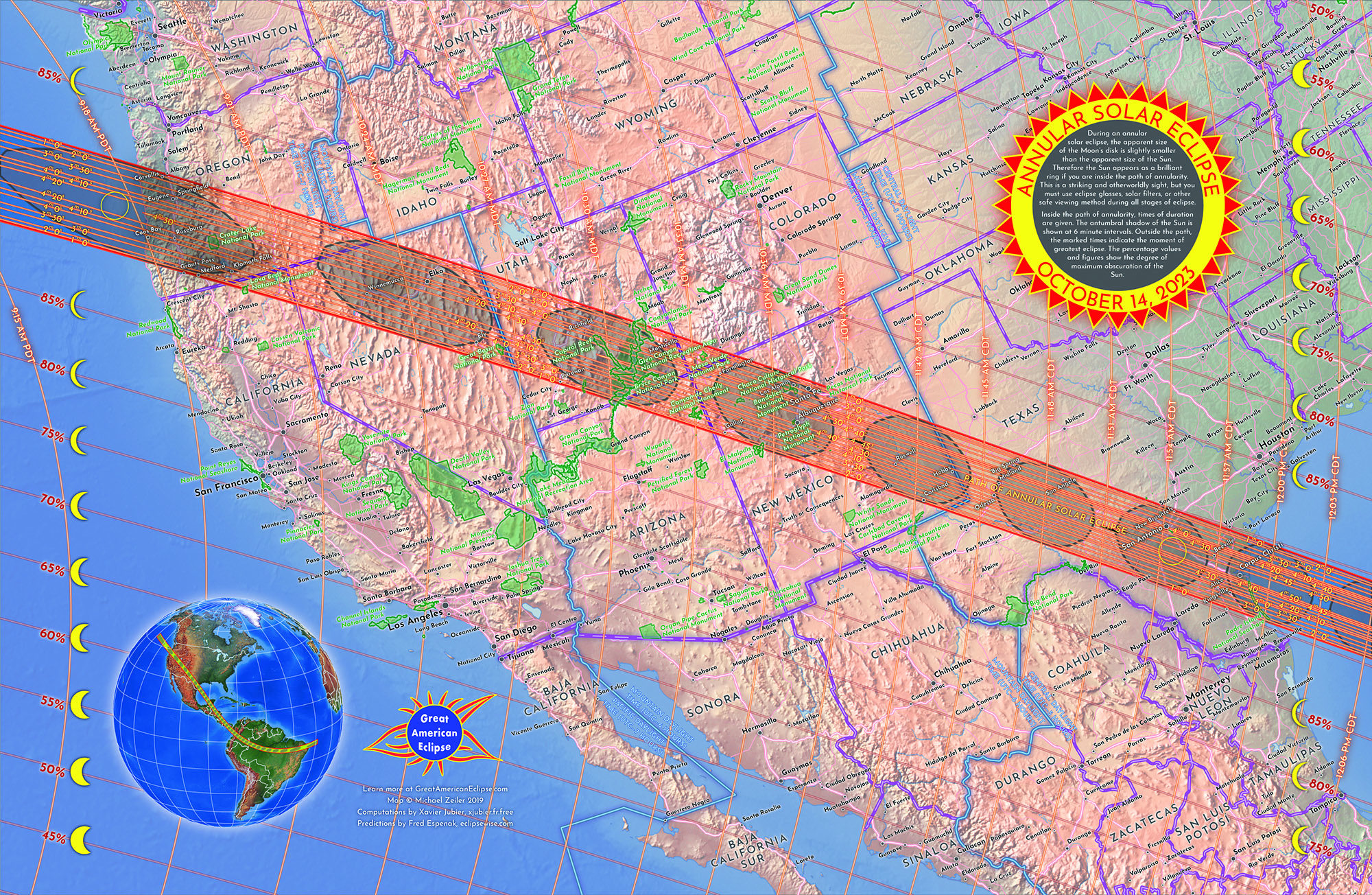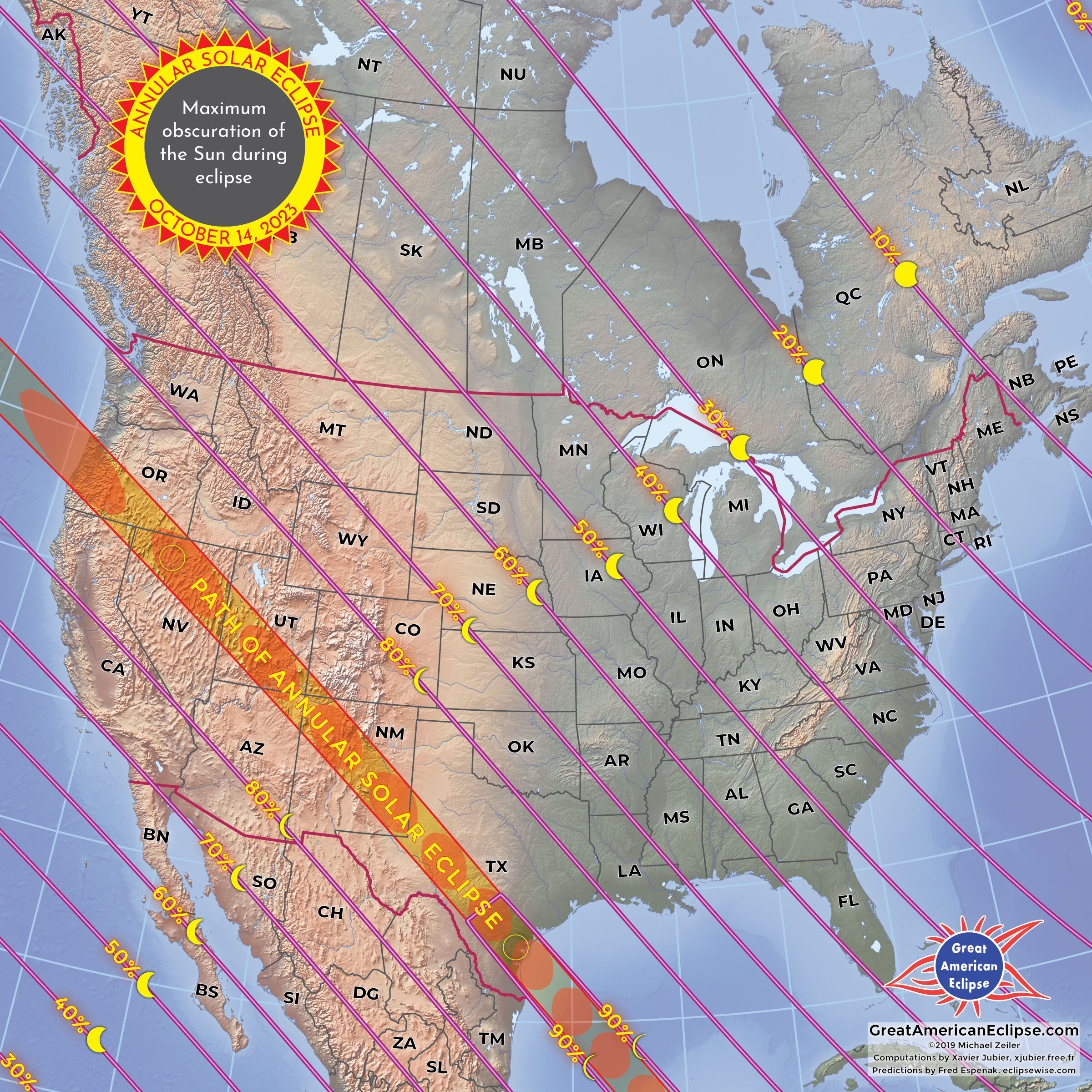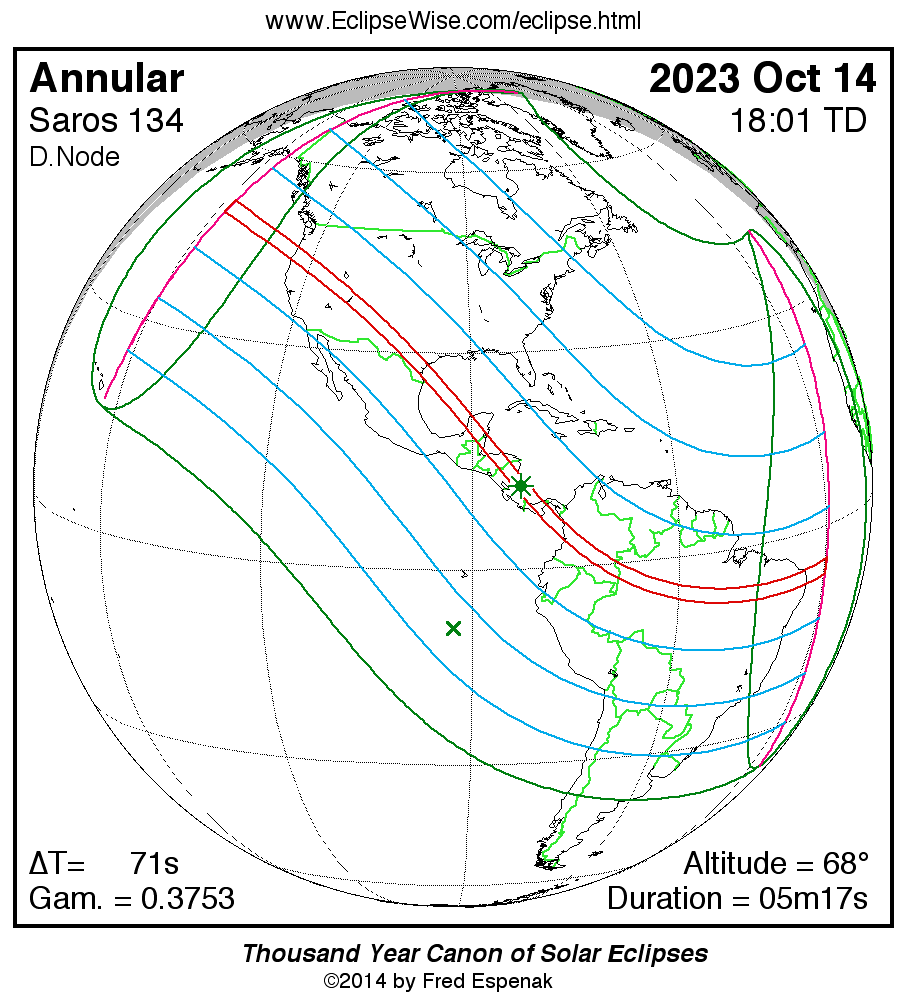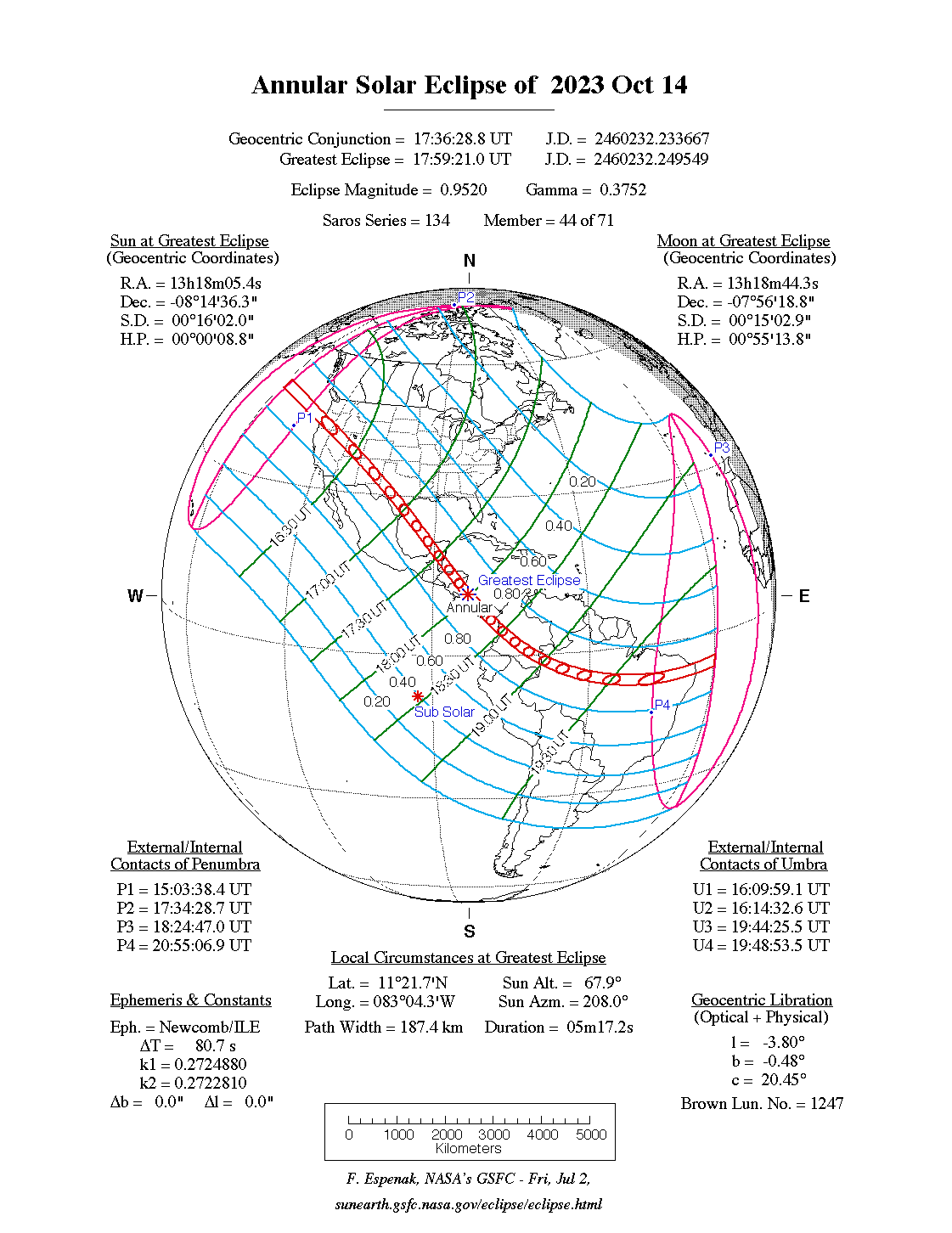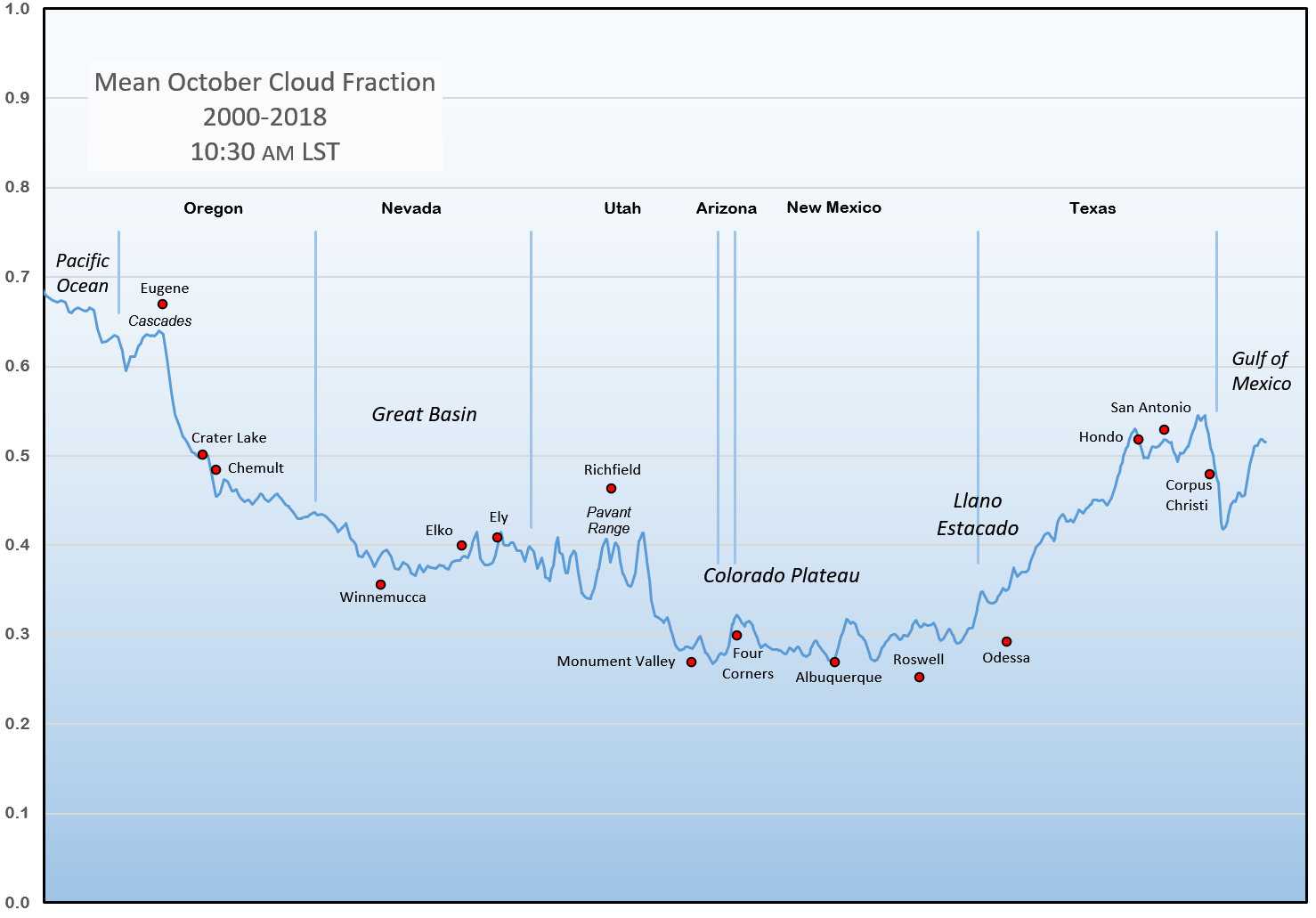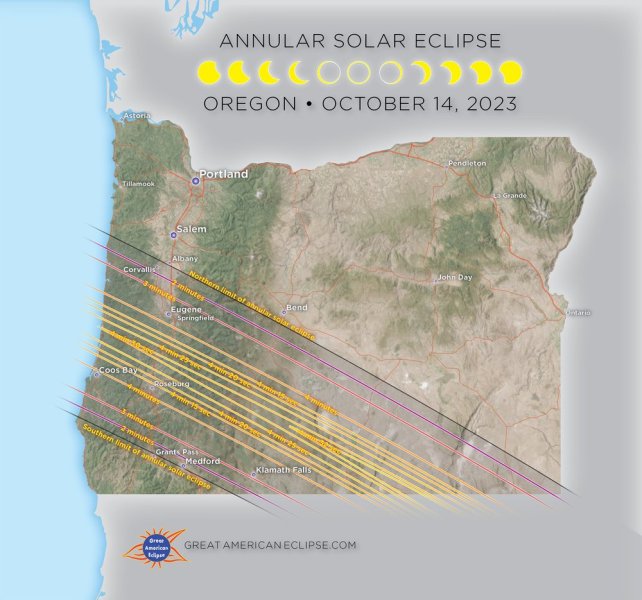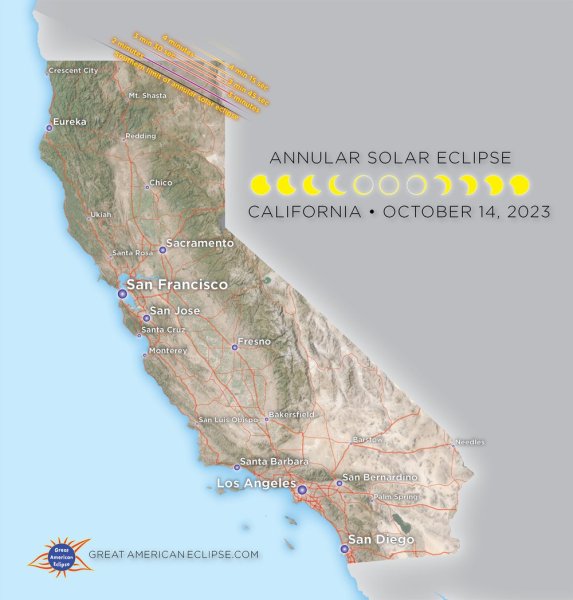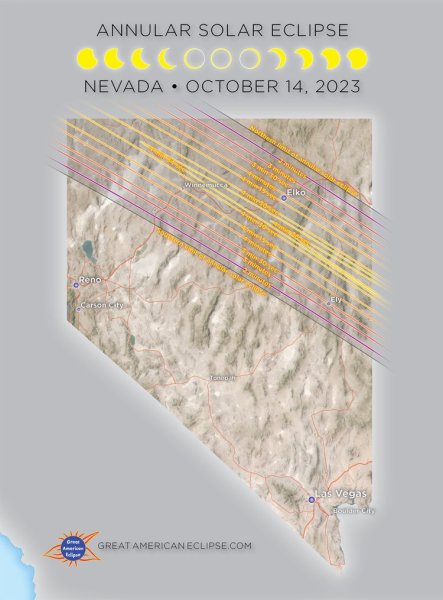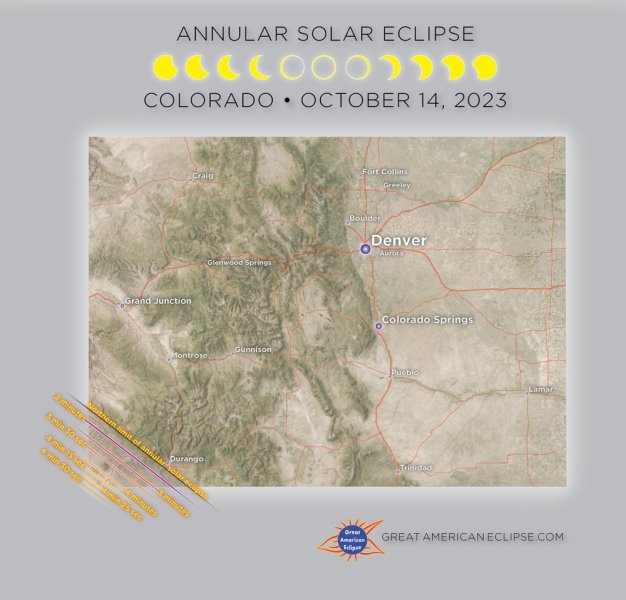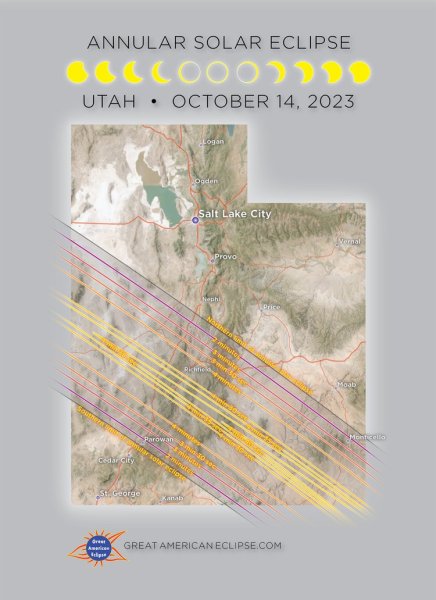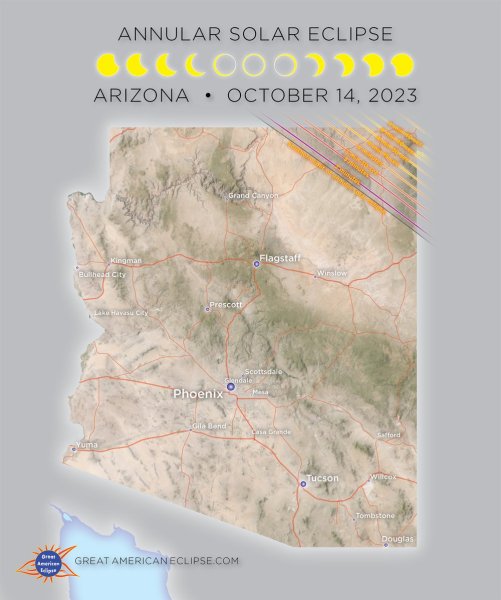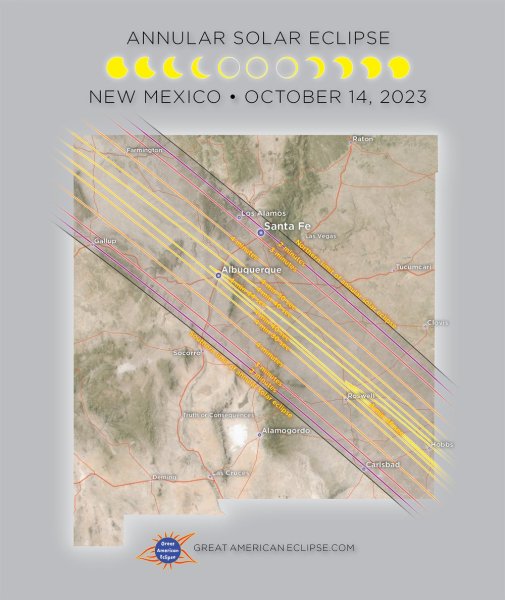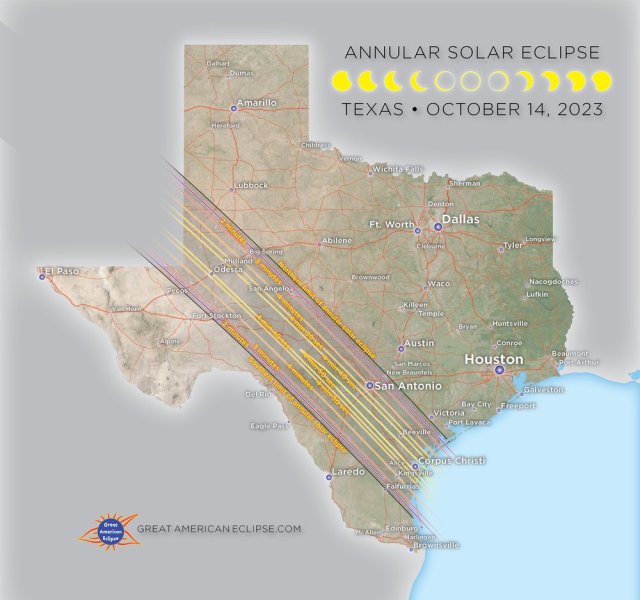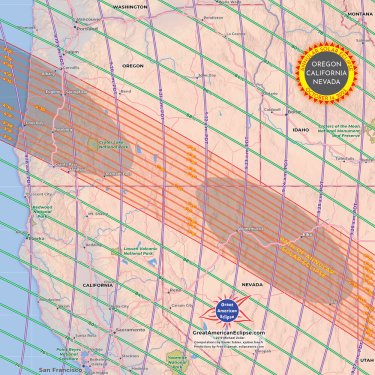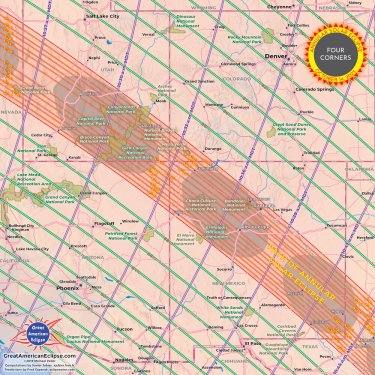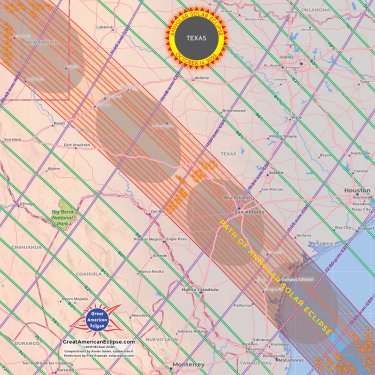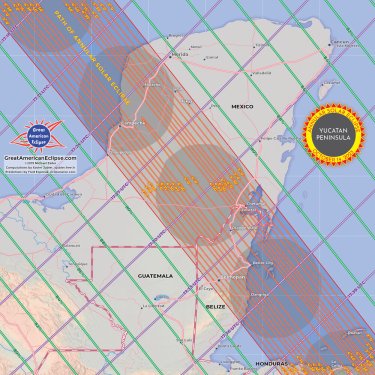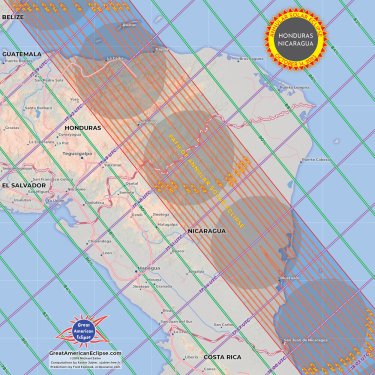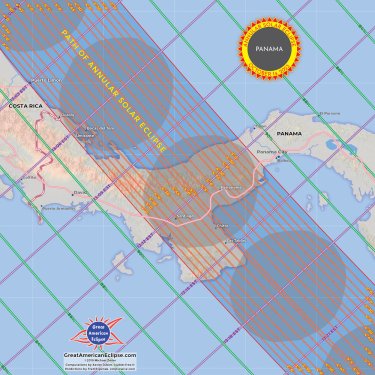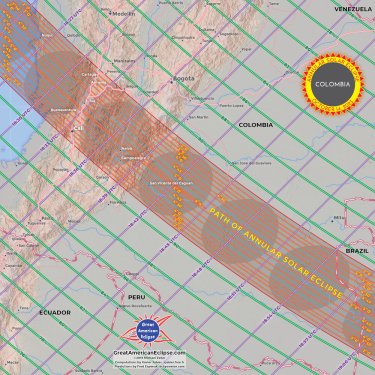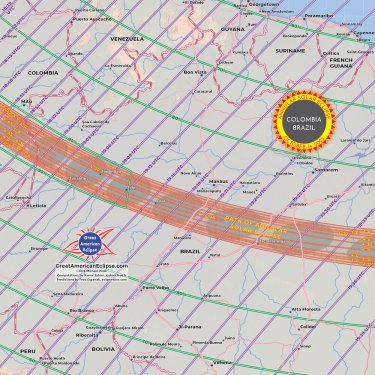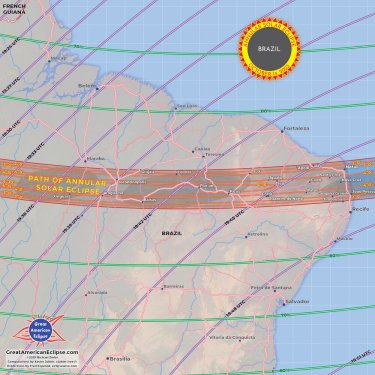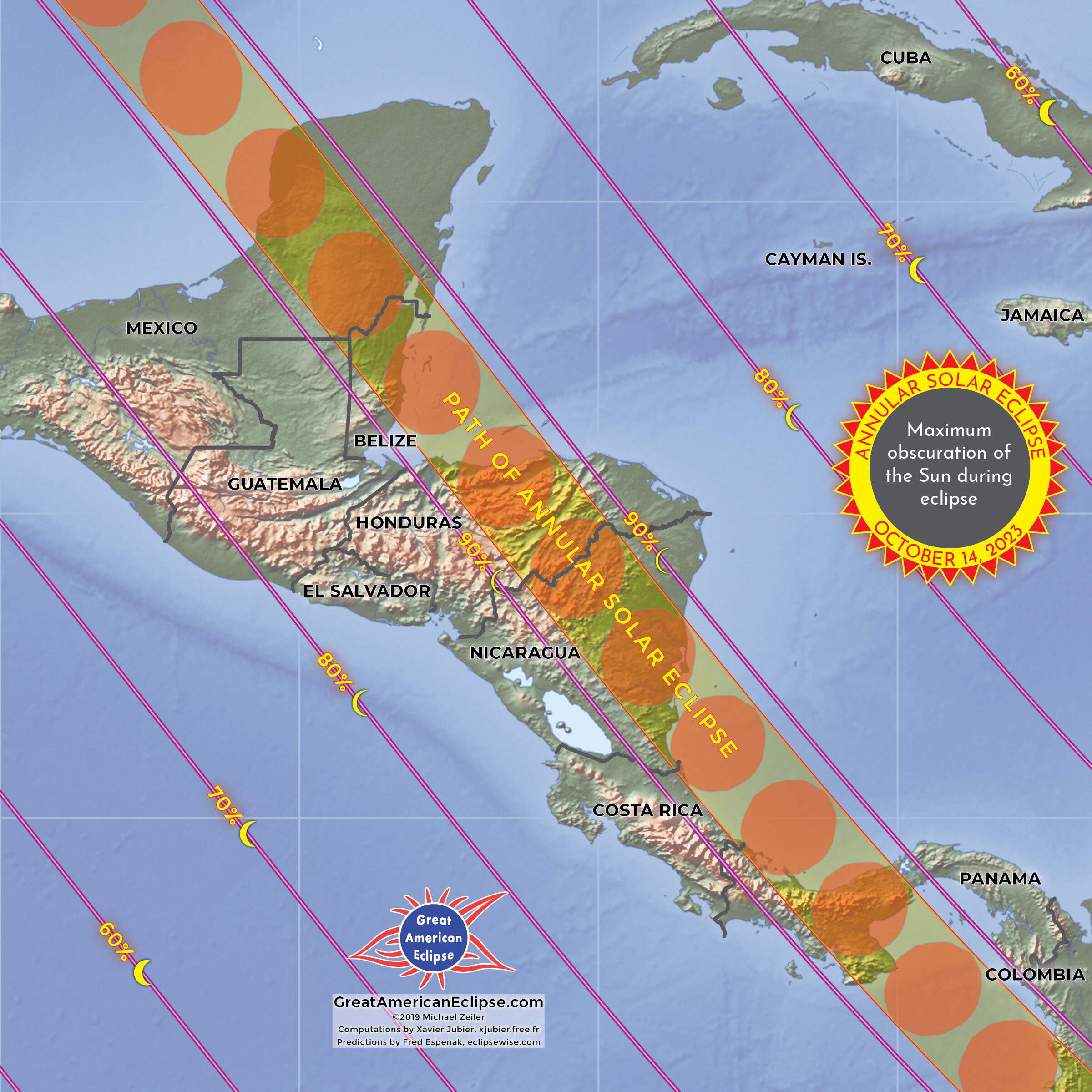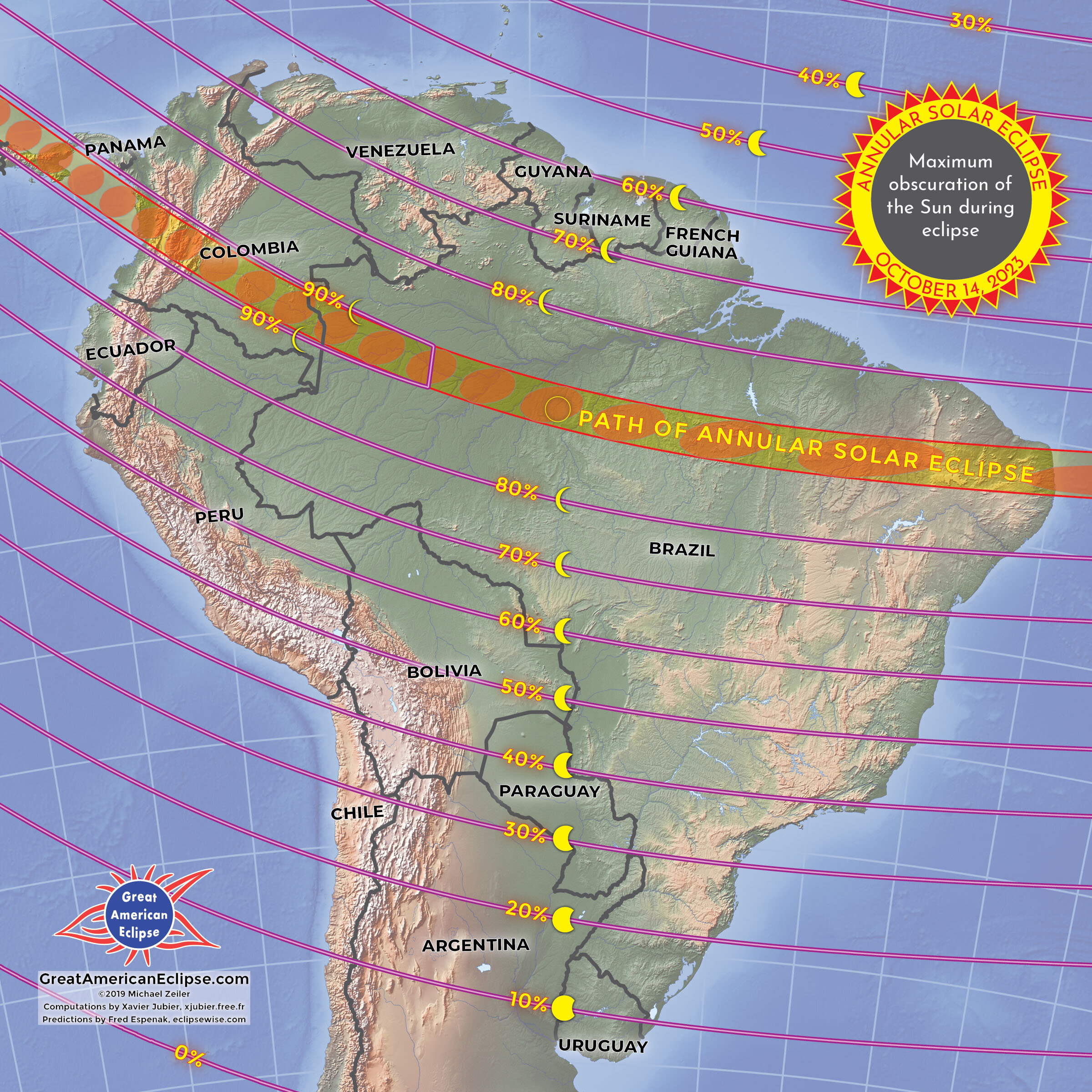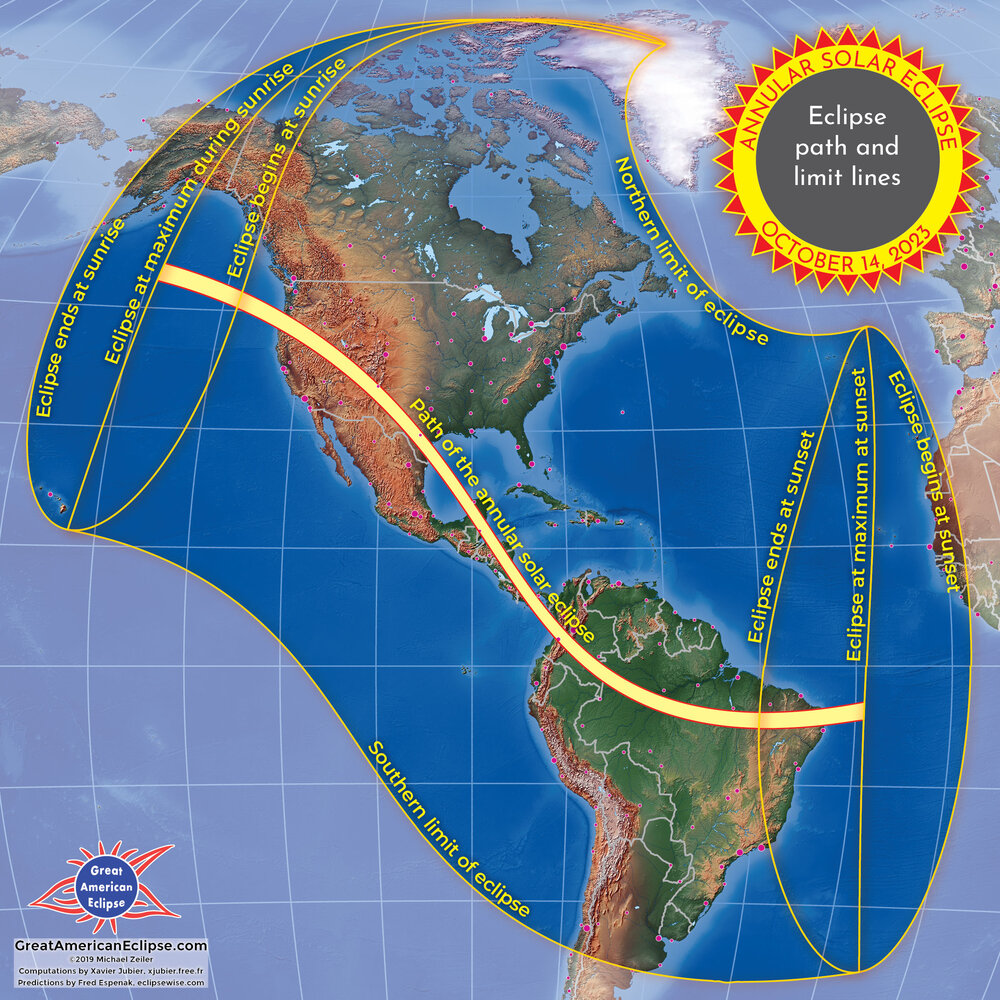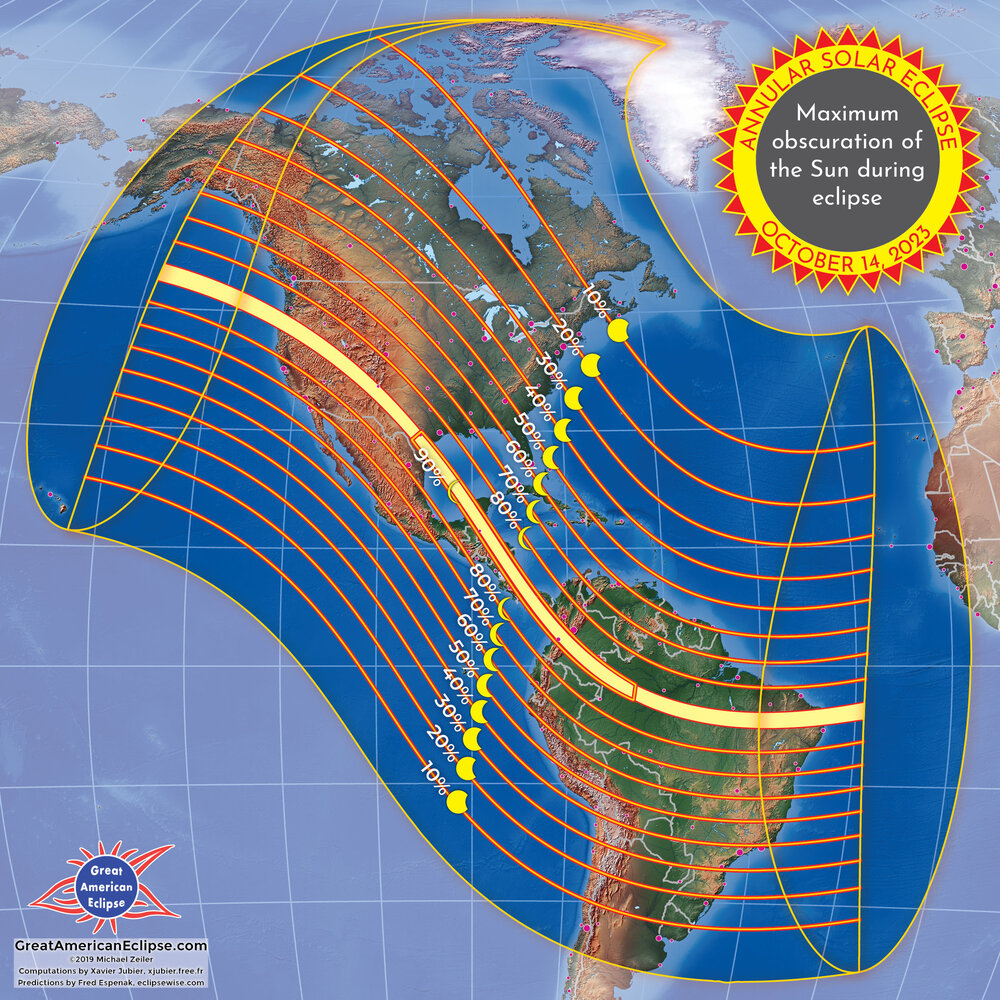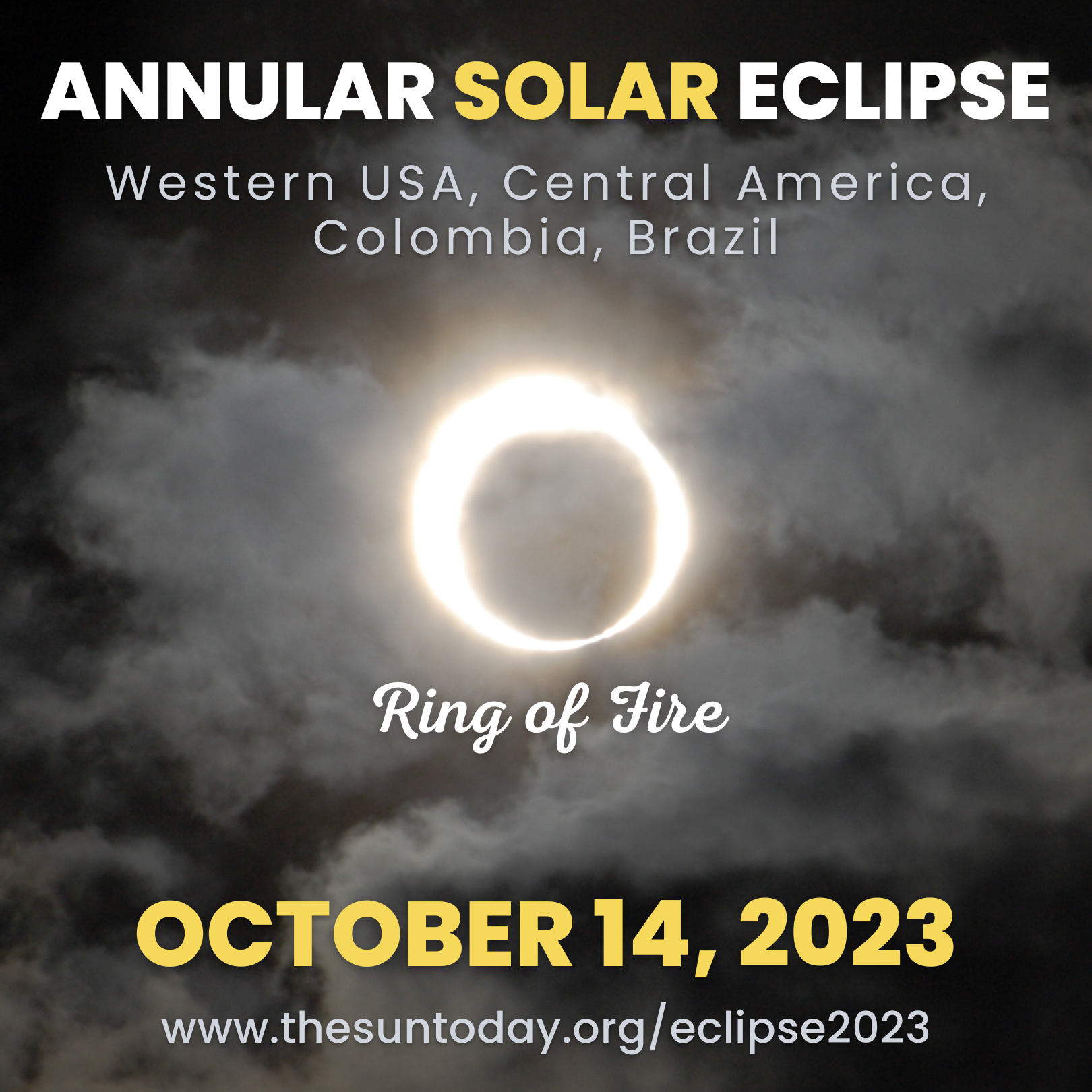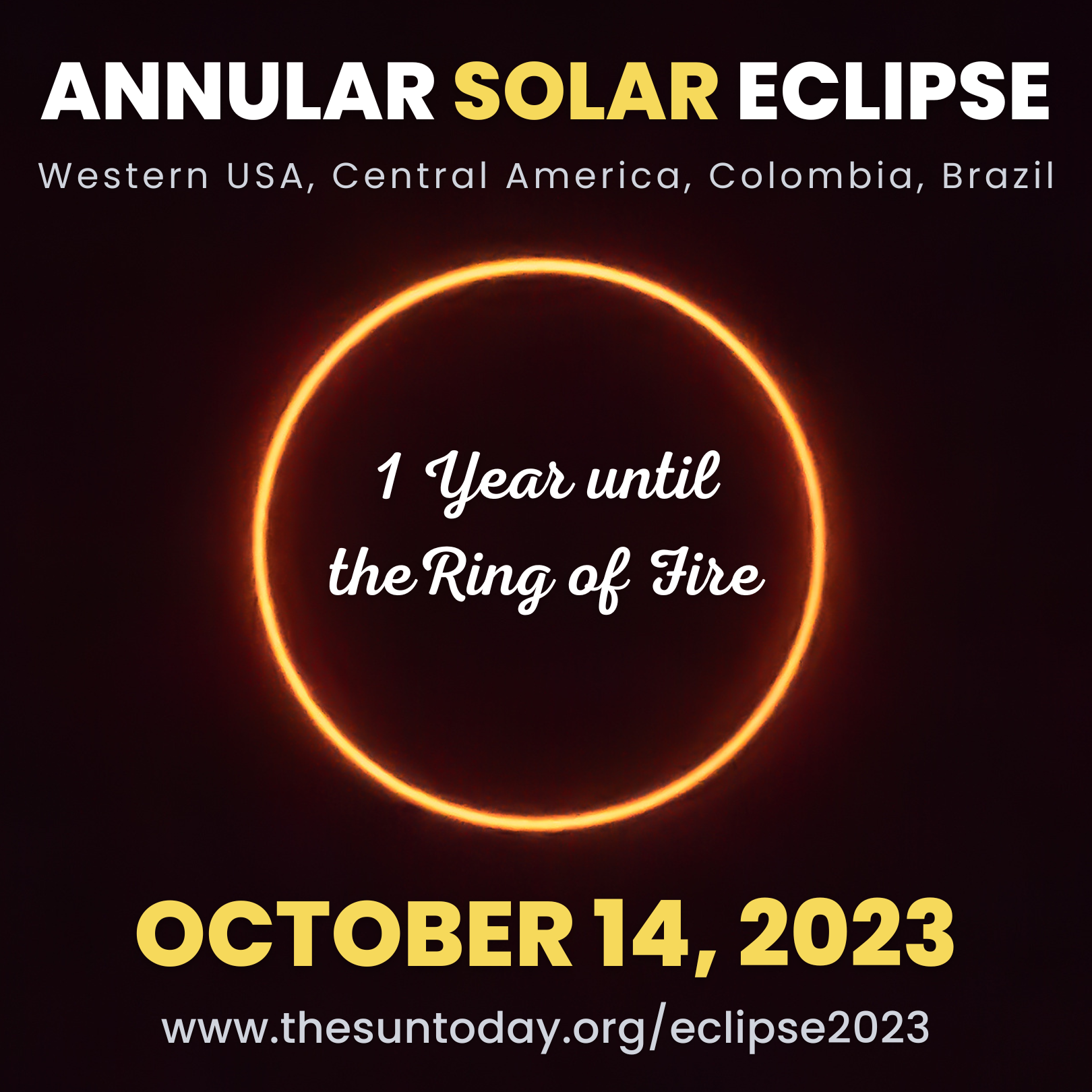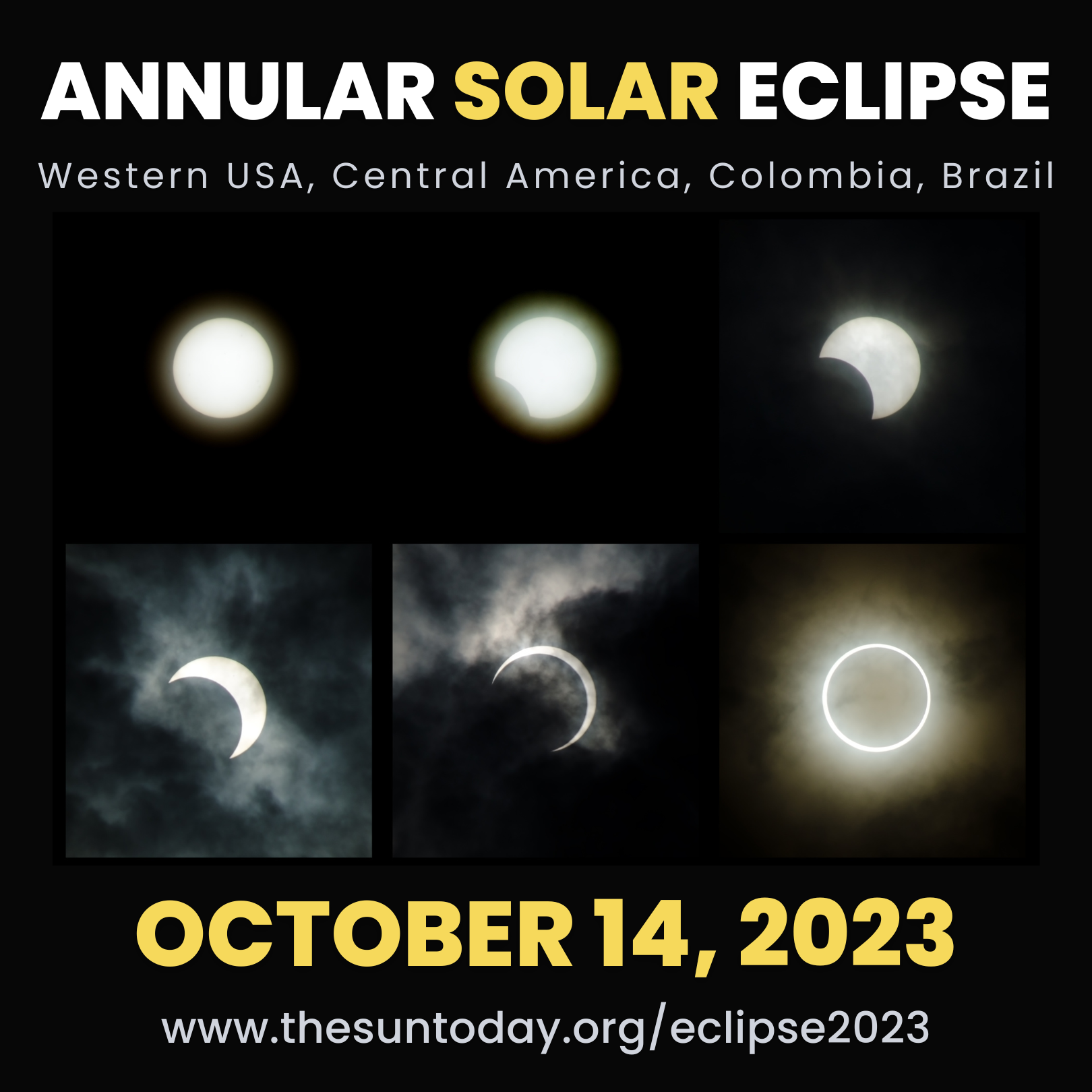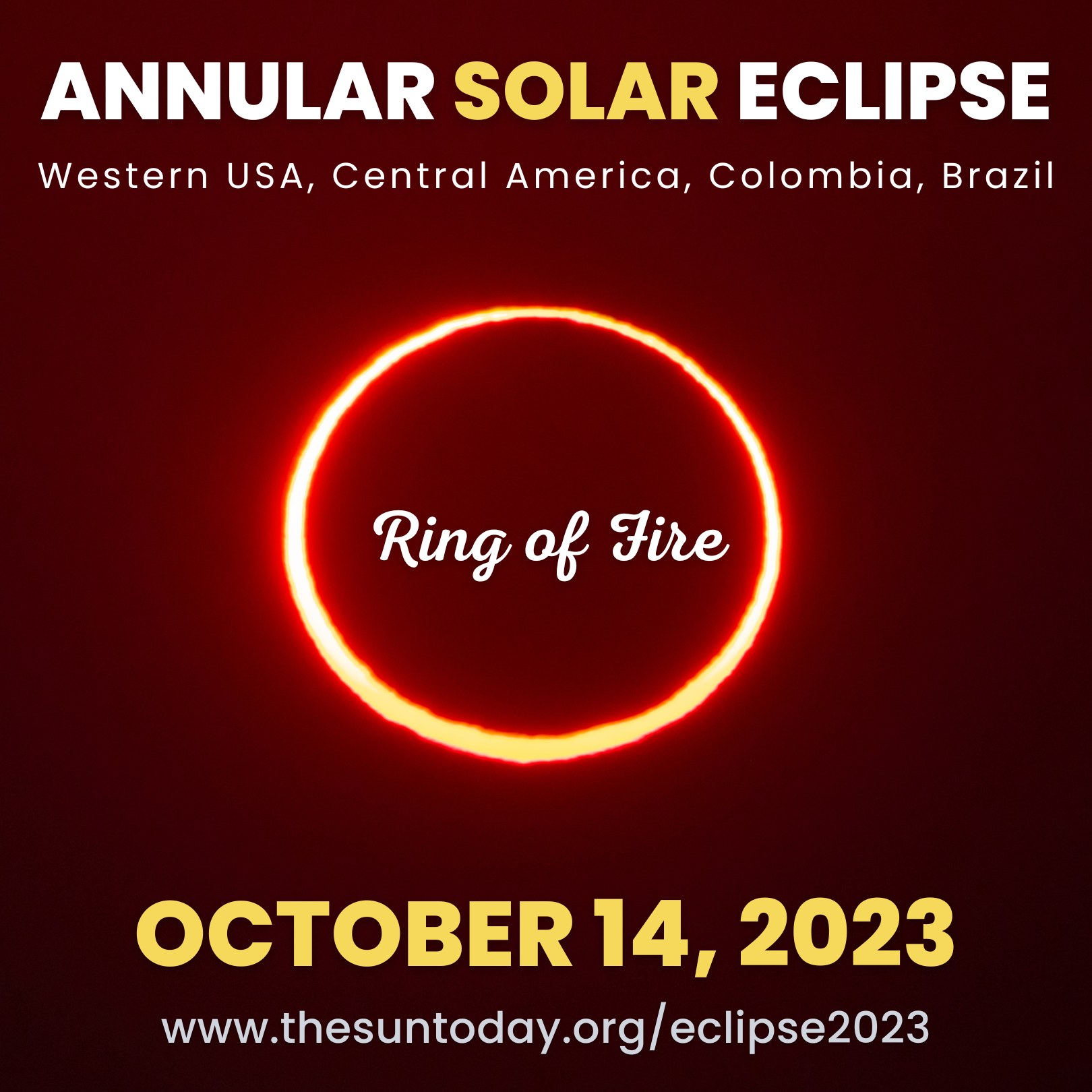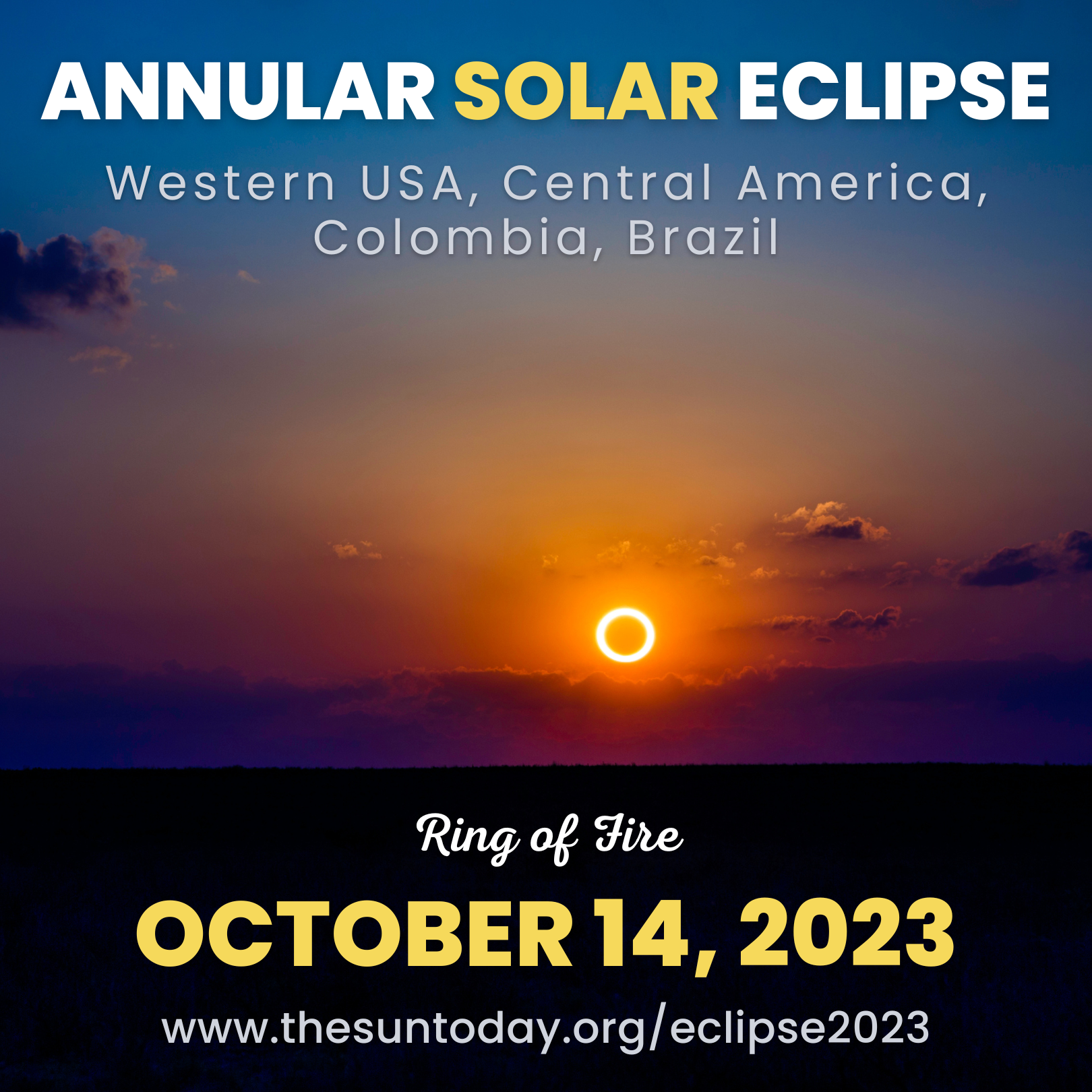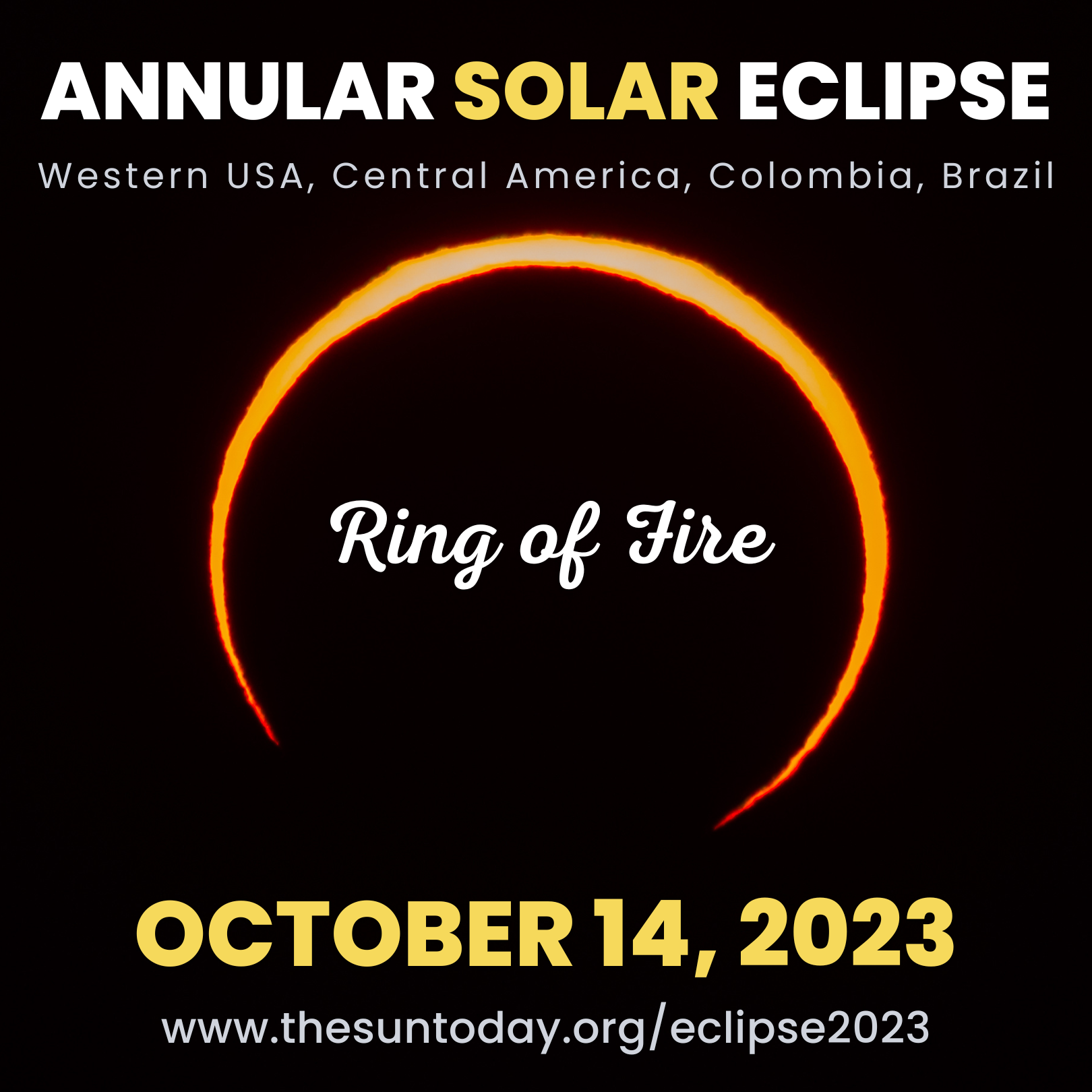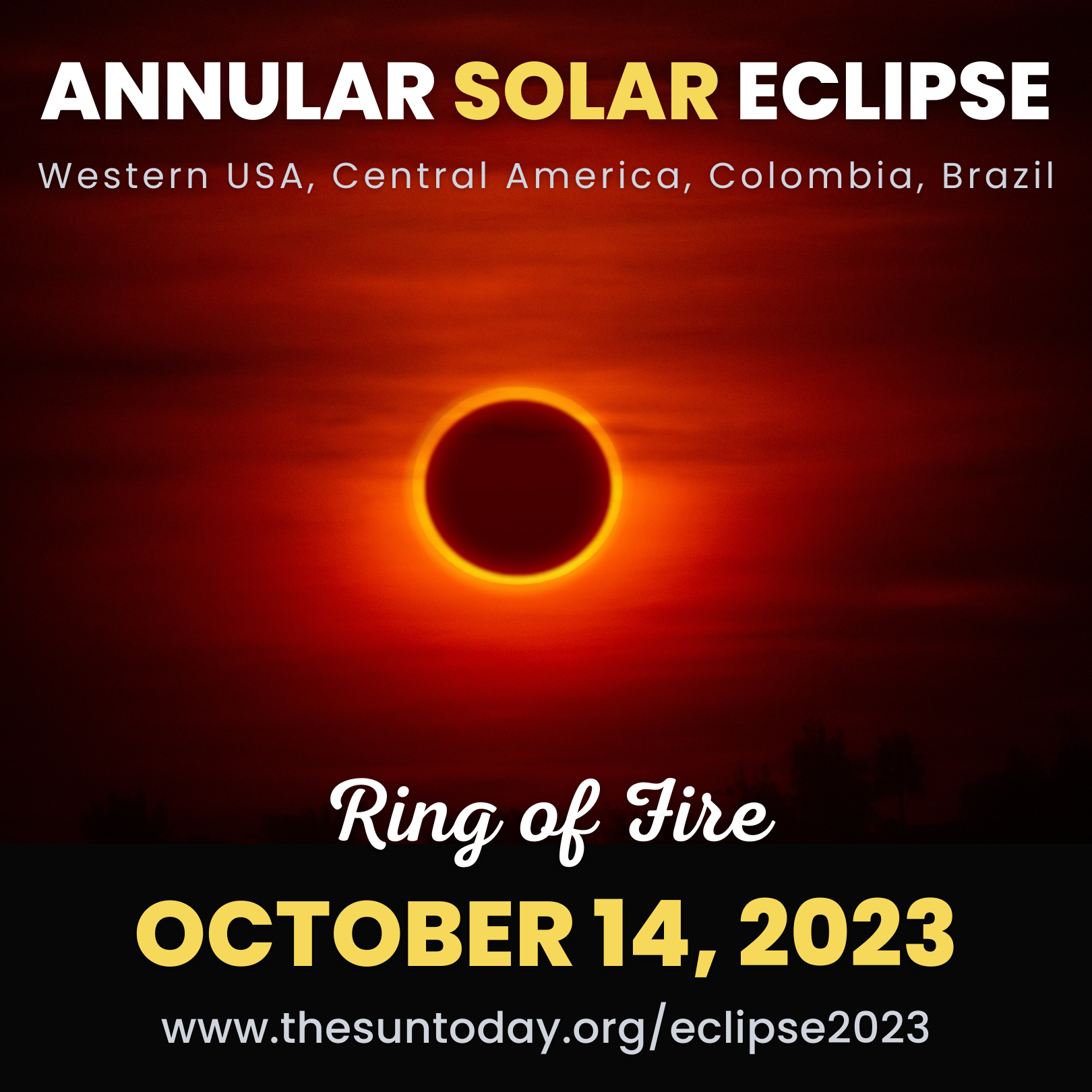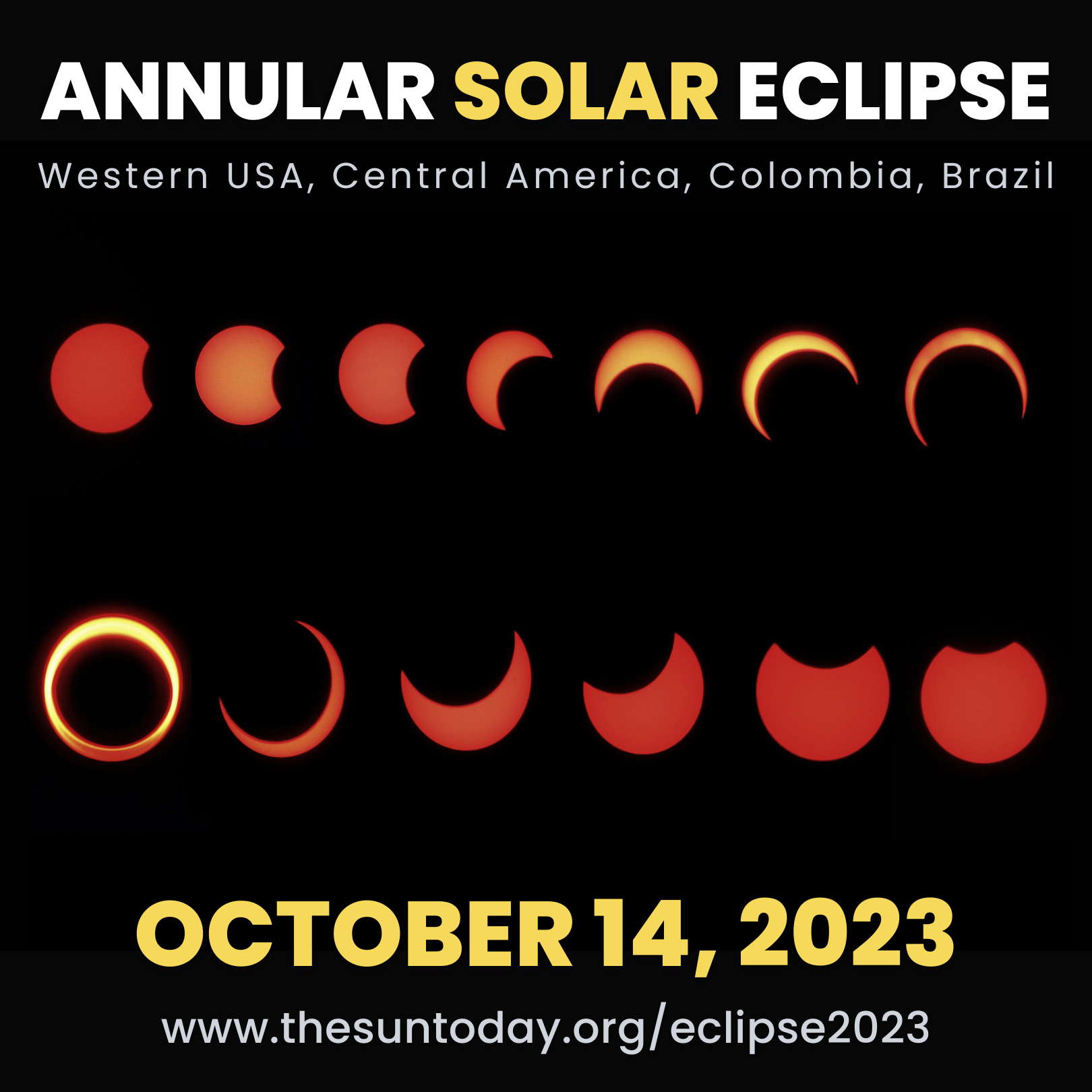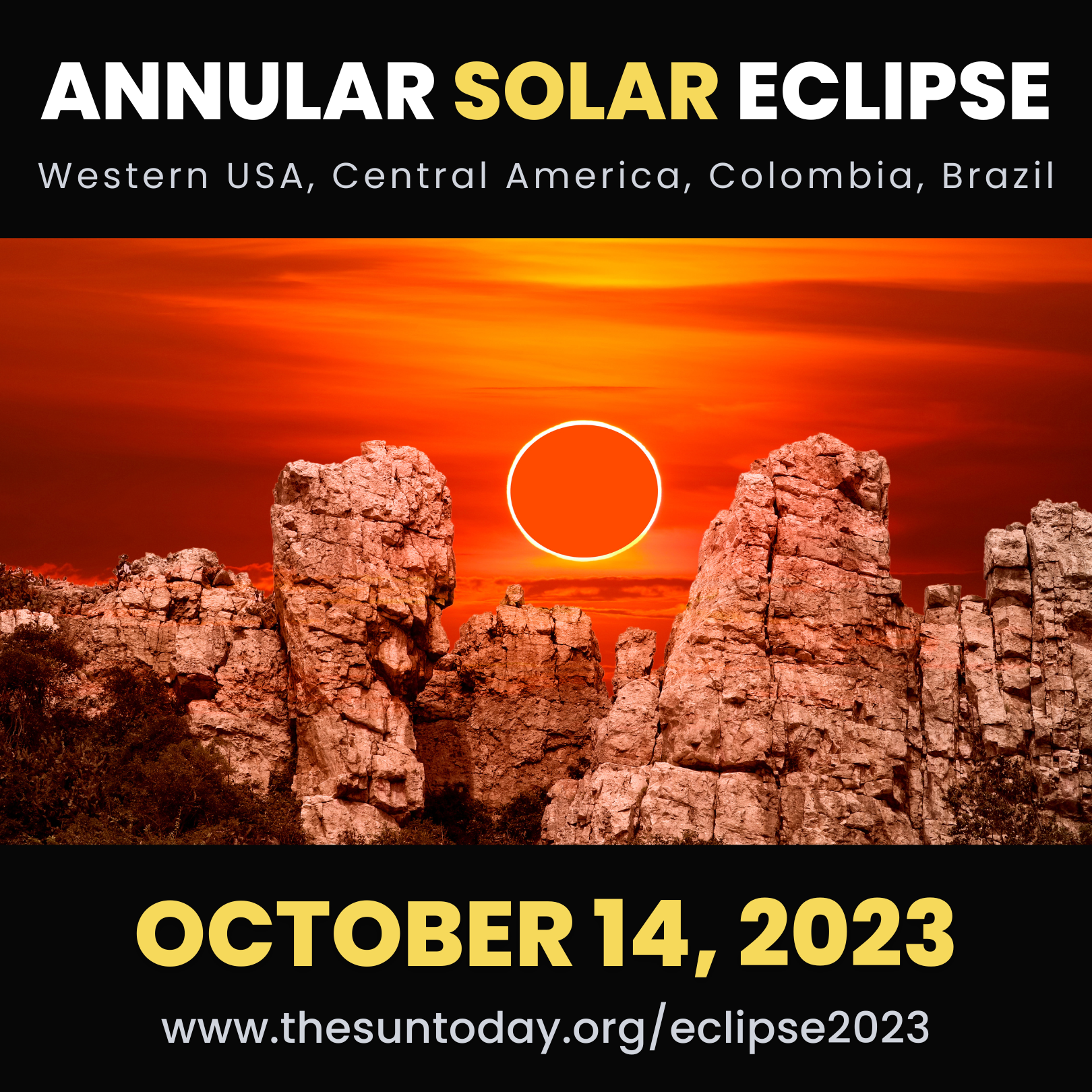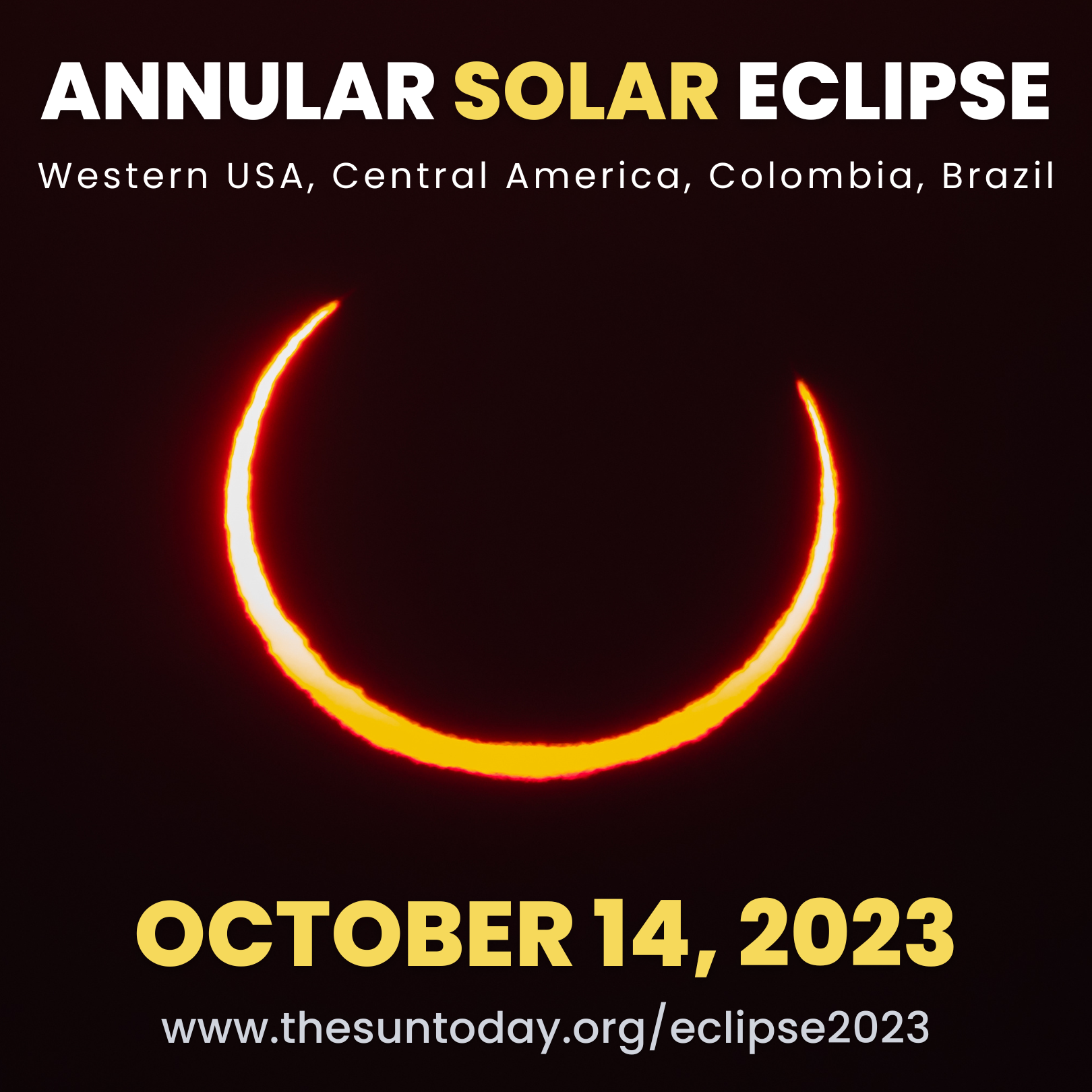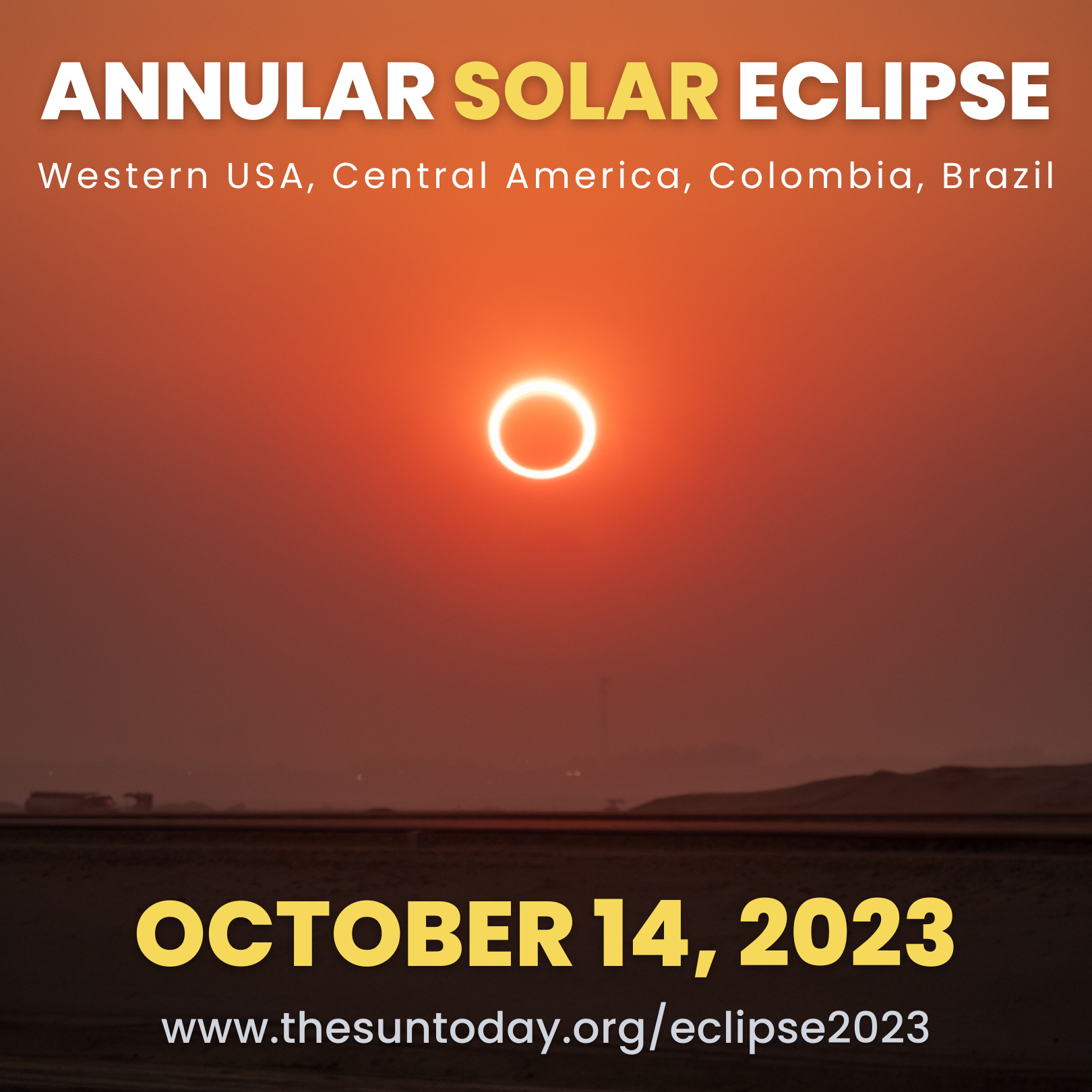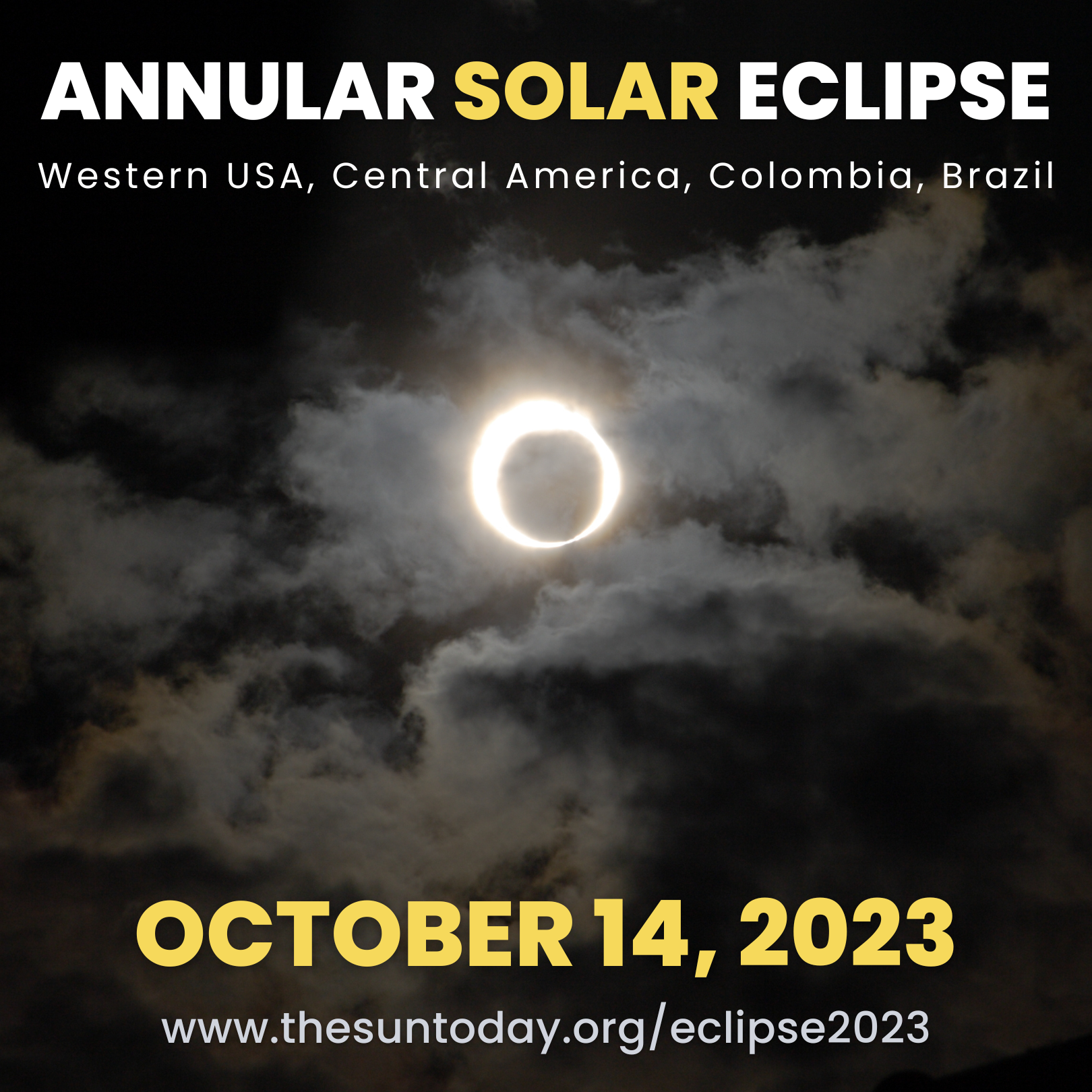Annular Solar Eclipse
🌞 🌑 🌎 October 14, 2023 😎 💍 🔥
Western USA, Central America, Colombia & Brazil
An annular solar eclipse occurs when the Moon’s apparent diameter is smaller than the Sun’s, blocking most of the Sun’s light and causing the Sun to look like an annulus (ring). You MUST HAVE EYE PROTECTION to view or watch it online!
Photo Credit: Stefan Seip
In the USA, the annular solar eclipse began in Oregon at 9:13 a.m. PDT
and ended in Texas at 12:03 p.m. CDT.
The maximum duration was 5 minutes, 17 seconds.
The maximum band is 116 mi (187 km).

Watch Replays
The Sun Today’s C. Alex Young was live in San Antonio with The Weather Channel’s Alex Wilson! Check out all of TWC’s coverage.
Watch the live stream and get details at timeanddate.com.

Credit: Rice Space Institute

The annular solar eclipse of February 26, 2017, photographed from Patagonia, South America. The sequence goes from left to right, with the Moon moving from upper left to lower right. For this eclipse the Moon covered about 98% of the Sun’s bright face, leaving only a very thin “ring of fire” still shining. During the October 14, 2023, annular eclipse the ring will be fatter, as the Moon will cover only about 90% of the Sun. Courtesy Jay M. Pasachoff and Christian Lockwood.

CREDIT: AAS
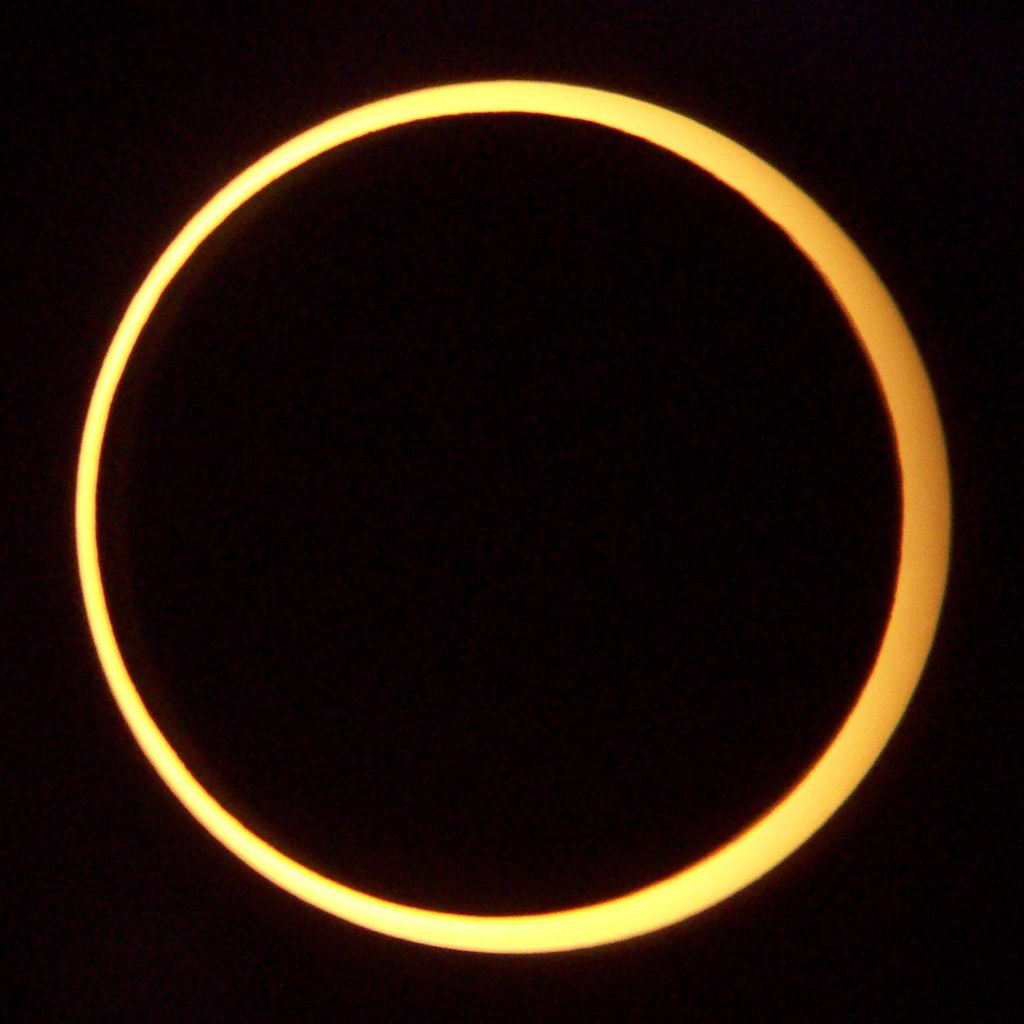
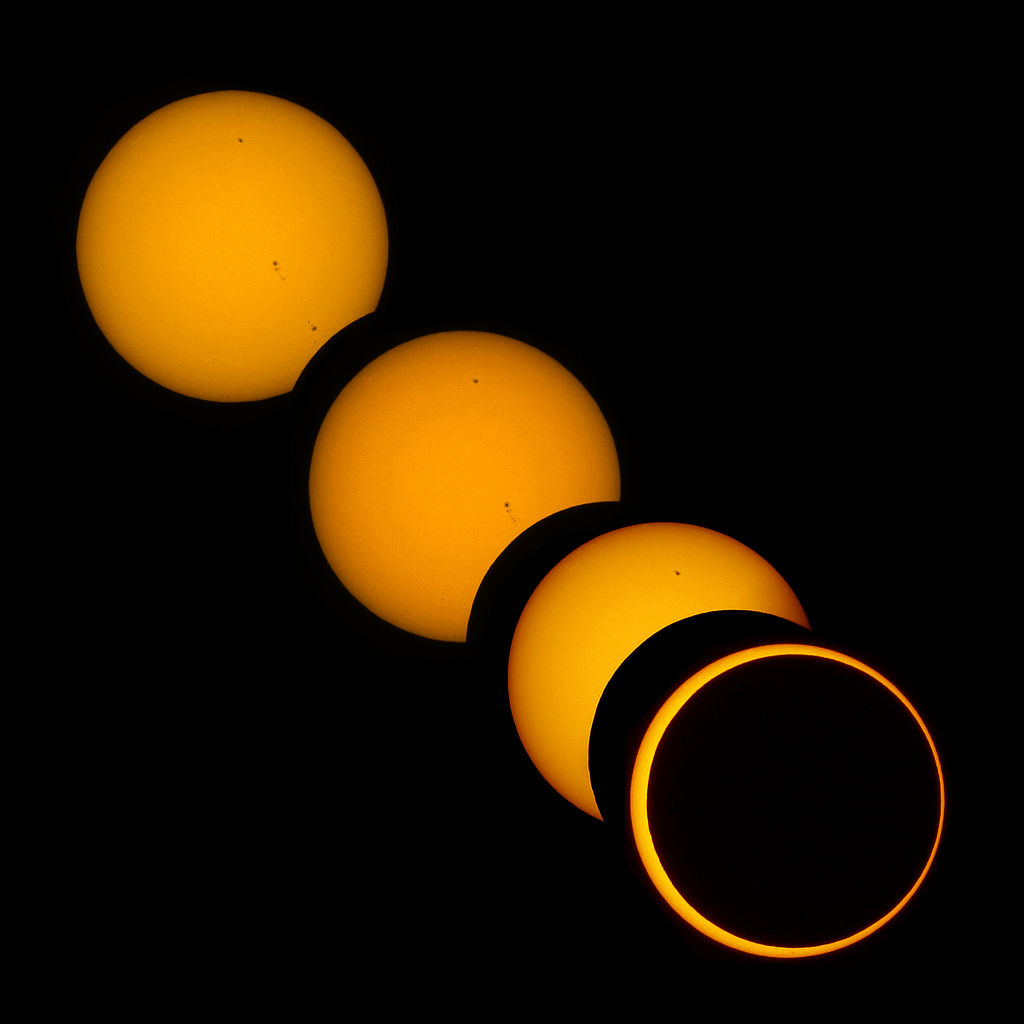
On October 14, 2023, the Moon will again pass directly between Earth and the Sun — but this time it will not quite completely cover the solar disk, instead turning it into a thin “ring of fire.”
This annular (Latin for ring-shaped) eclipse will be visible within a roughly 125-mile-wide path from Oregon to Texas and on into Mexico, Central America, and South America. Again, North Americans outside the path will be treated to a partial solar eclipse if the weather cooperates. (CREDIT: AAS)
This will be the second annular eclipse visible from Albuquerque in 11 years, where it crosses the path of the May 2012 eclipse.
The annular solar eclipse is part 1 of a double eclipse show for the USA!
Start making plans now to see this annular eclipse and the next total solar eclipse on April 8, 2024. After that, you’ll have to travel, because you won’t see another one in the US until 2045!! Get to the path of totality in 2024, and hope for no clouds.
Occurring only 4.6 days after apogee (the point in the orbit of the Moon at which it is furthest from the Earth – October 10, 2023), the Moon’s apparent diameter will be smaller.
An annular solar eclipse occurs when the Moon’s apparent diameter is smaller than the Sun’s, blocking most of the Sun’s light and causing the Sun to look like an annulus (ring). An annular eclipse appears as a partial eclipse over a region of the Earth thousands of kilometers or miles wide.
- Date: Saturday, October 14, 2023
- Gamma: 0.3753
- Magnitude: 0.952
- Saros: 134 (44 of 71)
- Greatest eclipse: 18:00:41
- Max. width of band: 187 km (116 mi)
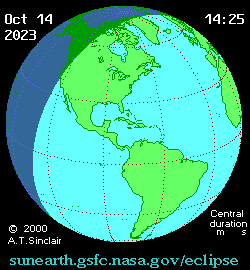
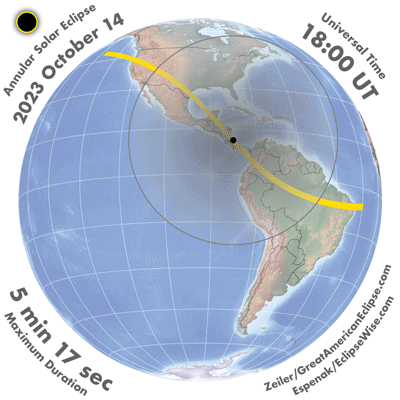
This animation shows the Moon’s shadows as it sweeps across a global map of Earth (an orthographic projection) for the October 14, 2023, annular eclipse.
The vantage point of the animation is seen from the Moon. The daylight hemisphere of Earth then faces the Moon and the lunar shadows appear perfectly circular with no distorted projection effects as they race across Earth.
The Moon’s antumbral shadow is the small black disk and tracks along the path of annularity (yellow strip). The much larger penumbral shadow is lightly shaded and outlined with a solid black edge. A partial eclipse is visible from within the penumbra, while an annular eclipse is visible inside the antumbra. Another consequence of this viewing geometry is that the Moon’s shadows move across the disk of Earth in a straight line.
On the upper left corner of the map is the type of eclipse and the eclipse date. To the upper right is the Universal Time. The lower left corner displays the instantaneous duration of annularity. To the lower right is the credit for the animation.
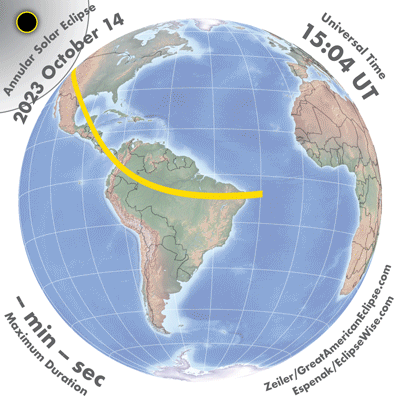
This animation shows the passage of the Moon’s shadow over the United States on October 14, 2023. During an annular solar eclipse, the Moon’s apparent disk is slightly smaller than the Sun and inside the path of annular solar eclipse, you will see the dramatic sight of the Sun as a thin ring. Be sure to use solar eclipse glasses or other safe viewing method at all times during this eclipse. Details and eclipse glasses are at greatamericaneclipse.com
October 14, 2023 Annular Eclipse – When and where can you see it?
The eclipse starts at one location and ends at another. The times below are actual times (in UTC) when the eclipse occurs. (Credit: timeanddate.com)
| Event | UTC Time | Time in Washington DC* |
|---|---|---|
| The first location to see the partial eclipse begin | Oct 14 at 15:03:45 | Oct 14 at 11:03:45 am |
| The first location to see the full eclipse begin | Oct 14 at 16:10:09 | Oct 14 at 12:10:09 pm |
| Maximum Eclipse | Oct 14 at 17:59:27 | Oct 14 at 1:59:27 pm |
| Last location to see the full eclipse end | Oct 14 at 19:48:56 | Oct 14 at 3:48:56 pm |
| Last location to see the partial eclipse end | Oct 14 at 20:55:11 | Oct 14 at 4:55:11 pm |
* These local times do not refer to a specific location but indicate the beginning, peak, and end of the eclipse on a global scale, with each line referring to a different location. Please note that the local times for Washington DC are meant as a guideline in case you want to view the eclipse via a live webcam. They do not mean that the eclipse is necessarily visible there.
When the Eclipse Happens at Specific Locations — Timeline
A few select locations within the path of annularity. The eclipse begins and ends as a partial eclipse. The beginning, maximum, and end of annularity are listed between the partial phases. Credit: NASA
| Location | Partial Eclipse Begins | Annularity Begins | Maximum | Annularity Ends | Partial Eclipse Ends |
|---|---|---|---|---|---|
| Eugene, Oregon | 8:06 a.m. PDT | 9:16 a.m. PDT | 9:18 a.m. PDT | 9:20 a.m. PDT | 10:39 a.m. PDT |
| Alturas, California | 8:05 a.m. PDT | 9:19 a.m. PDT | 9:20 a.m. PDT | 9:21 a.m. PDT | 10:43 a.m. PDT |
| Battle Mountain, Nevada | 8:06 a.m. PDT | 9:21 a.m. PDT | 9:23 a.m. PDT | 9:25 a.m. PDT | 10:48 a.m. PDT |
| Richfield, Utah | 9:09 a.m. MDT | 10:26 a.m. MDT | 10:28 a.m. MDT | 10:31 a.m. MDT | 11:56 a.m. MDT |
| Albuquerque, New Mexico | 9:13 a.m. MDT | 10:34 a.m. MDT | 10:35 a.m. MDT | 10:39 a.m. MDT | 12:09 p.m. MDT |
| San Antonio, Texas | 10:23 a.m. CDT | 11:52 a.m. CDT | 11:54 a.m. CDT | 11:56 a.m. CDT | 1:33 p.m. CDT |
You Need Clear Skies to See the Eclipse
This graph shows the average October cloud cover (2000-2018) from satellite measurements at 10:30 am local time along the centerline of the October 14, 2023, annular eclipse track. Units are fractional sky cover, which can be interpreted as percent cloud cover. Courtesy Jay Anderson, Eclipsophile.com via AAS.
9 states are touched by the path of the Annular Solar Eclipse
The states that the Moon’s shadow will visit during the annular solar eclipse are Oregon, California, Idaho, Nevada, Utah, Colorado, Arizona, New Mexico, and Texas. Great American Eclipse created the maps below for each of these states. Idaho is omitted because the Moon’s shadow only touches a small corner of this state. Click to view a larger version.
MAP CREDIT: greatamericaneclipse.com
Detailed Maps
Annular solar eclipse of October 14, 2023
Click the images to view larger & a caption with details.
CREDIT: GreatAmericanEclipse.com
